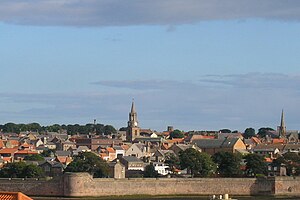Siege of Berwick (1318)
| date | 1. bis 2. April 1318 |
|---|---|
| place | Berwick-upon-Tweed |
| output | The Scots conquered the city |
| Parties to the conflict | |
|---|---|
| Commander | |
|
unknown |
|
| Troop strength | |
| unknown | unknown |
| losses | |
|
unknown |
unknown |
Battles of the First Scottish War of Independence
Berwick - Dunbar - Stirling Bridge - Falkirk - Roslin - Stirling Castle - Methven - Dalry - Glen Trool - Loudoun Hill - Inverurie - Brander - Perth - Bannockburn - Berwick - Berwick - Myton - Byland - Weardale
Battles of the Second Scottish Revolutionary War
Kinghorn - Dupplin Moor - Annan - Berwick - Halidon Hill - Boroughmuir - Culblean - Neville's Cross
The Siege of Berwick was a battle of the First Scottish War of Independence . Since 1315, Berwick , which was occupied by an English garrison, was blocked by Scottish troops. Presumably on the night of April 1 to April 2, 1318 , the Scots finally conquered the city through treason.
prehistory
By the end of the 13th century, Berwick had been the largest and most important Scottish city. At the beginning of the war with Scotland, the English King Edward I had conquered the city and had it plundered in 1296 . The fortifications of the city were considerably strengthened under King Edward II . Since 1308, however, the Scots were able to push back the English troops in Scotland under King Robert I. After the Battle of Bannockburn and the capture of Stirling Castle in 1314, Berwick, not far from the old border with England, was the last Scottish fortress to be in English hands.
Blockade of Berwick
After the Battle of Bannockburn, Scottish troops put increasing pressure on the English garrison at Berwick. The town was threatened by Scottish troops on land, while Flemish pirates, allied with Scotland, such as John Crab, hijacked English ships that were supposed to supply the town. On January 7, 1316, the English occupation under Maurice de Berkeley was only just able to repel a Scottish surprise attack led by King Robert I. In February 1316, the crew was so starved that the crew had to eat the meat of their dead horses. Berkeley was replaced in June 1316, in June 1317 Edward II entrusted the citizens of Berwick with the defense of the city. Tensions soon developed between them and the commander of the English soldiers.
Conquering the city
At the onset of winter in late autumn 1317, the Scots first stopped direct attacks on Berwick. In December 1317, however, Robert I had siege engines built in the Aldcampus, about twenty kilometers from Berwick . However, these were no longer used before Berwick. Peter of Spalding , a citizen of Berwick, is said to have given the Scottish attackers a route into the city. Apparently Spalding was related to Robert Keith , the Marischal of Scotland , and had offered to betray him. Keith reported it to Robert I, but the king initially feared that the offer was a trap. Then he commissioned his experienced military personnel Thomas Randolph, 1st Earl of Moray and James Douglas , to accept Spalding's offer. On the night of April 1 to April 2, according to other sources on the morning of March 28, Douglas carried out a surprise attack on Berwick. Spalding was the guard responsible for the section of the wall that Douglas and his men climbed up on rope ladders. In a fierce street fight in which Sir Willliam Keith of Galston excelled , the Scots were able to conquer the city. The trapped crew at Berwick Castle was starved and surrendered around June 18, some eleven weeks later.
consequences
The conquest of Berwick was a heavy defeat for the English, which was soon followed by the conquest of the smaller castles of Harbottle and Mitford in Northumberland . In contrast to the other forts that the Scots recaptured under Robert I, the Berwick fortifications were not demolished. In September 1319 King Edward II besieged Berwick in vain . Only after the Scottish defeat in the Battle of Halidon Hill in 1333 could the English recapture the city .
Individual evidence
- ↑ John Roland Seymour Phillips: Aymer de Valence, Earl of Pembroke, 1307-1324. Baronial politics in the reign of Edward II. Clarendon, Oxford 1972, ISBN 0-19-822359-5 , p. 91.
- ^ A b Ranald Nicholson: Scotland. The Later Middle Ages (The Edinburgh History of Scotland, Vol. II. ) Oliver and Boyd, Edinburgh 1974, ISBN 0-05-002038-2 , p. 97.
- ↑ Michael Penman: Robert the Bruce. King of the Scots . Yale University Press, New Haven 2014, ISBN 978-0-300-14872-5 , p. 182.
- ^ A b Geoffrey WS Barrow: Robert Bruce and the Community of the Realm of Scotland . Eyre & Spottiswoode, London 1965, p. 341.
- ^ Roy Martin Haines: King Edward II: His Life, His Reign, and Its Aftermath, 1284-1330 . McGill-Queen's University Press, Montreal 2003, ISBN 0-7735-2432-0 , p. 109.
- ^ Ranald Nicholson: Scotland. The Later Middle Ages (The Edinburgh History of Scotland, Vol. II. ) Oliver and Boyd, Edinburgh 1974, ISBN 0-05-002038-2 , p. 98.
